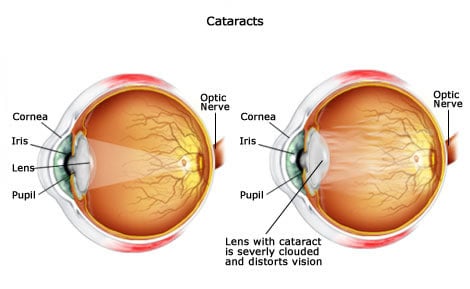What are Cataracts?
Cataract is the leading cause of blindness worldwide.
A cataract is a clouding of the lens in the eye that affects vision. There are currently more than 24 million Americans age 40 and older who have cataract, according to the Vision Problems in the U.S. report from Prevent Blindness America.

A cataract can occur in one or both eyes. The lens is the clear part of the eye that helps to focus light, or an image, onto the retina. The retina is the light-sensitive tissue at the back of the eye.
In a normal eye, light passes through the transparent lens to the retina. Once it reaches the retina, light is changed into nerve signals that are sent to the brain via the optic nerve.
The lens must be clear for the retina to receive a sharp image. As a result, if the lens is cloudy because of a cataract, the image you see will be impaired.
The risk of cataracts increases as you get older.
Other risk factors for cataract include:
- Certain diseases, such as diabetes
- Medications, such as steroids
- The environment (i.e. prolonged exposure to ultraviolet sunlight)
- Trauma or injury
The symptoms of cataracts include:
- Cloudy or blurred vision
- Faded colors
- Double or multiple images
- Poor night vision
Cataracts are detected through a comprehensive eye exam that includes:
- Visual acuity test. This eye chart test measures how well you see at various distances.
- Dilated eye exam. Drops are placed in your eyes to widen, or dilate, the pupils. Your ophthalmologist uses a special magnifying lens to examine your retina and optic nerve for signs of damage and other eye problems. After the exam, your close-up vision may remain blurred for several hours.
- Tonometry. An instrument measures the pressure inside the eye. Numbing drops may be applied to your eye for this test. Your ophthalmologist also may do other tests to learn more about the structure and health of your eye.
- A glare test may be performed.

